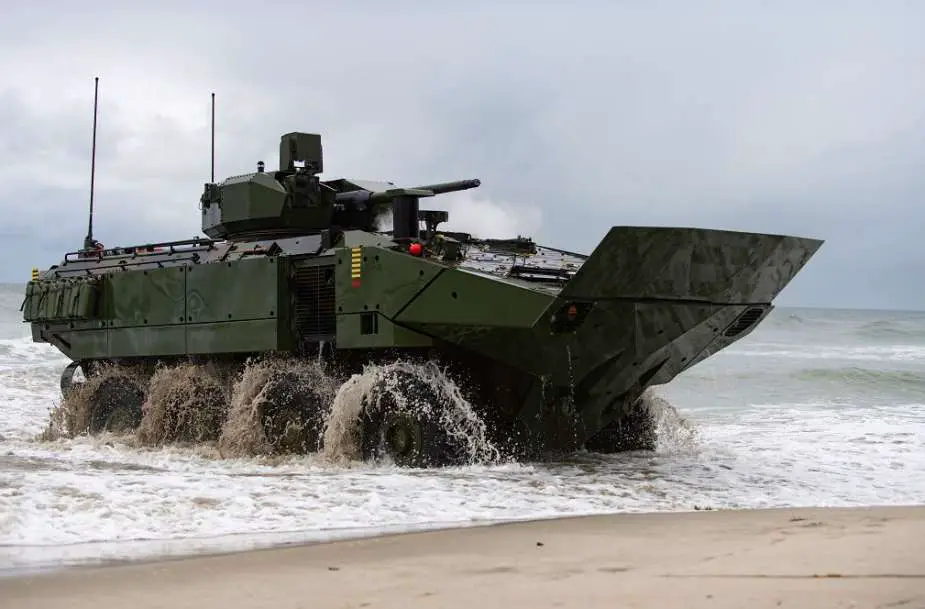On February 1, 2024, BAE Systems announced the delivery of the initial production representative test vehicle (PRTV) of the Amphibious Combat Vehicle 30mm Cannon (ACV-30) 8x8 amphibious armored vehicle to the US Marine Corps. This development is viewed as an important addition to the Marine Corps capabilities, aimed at enhancing direct fire support for dismounted Marines.
Follow Army Recognition on Google News at this link

The ACV-30 features a Kongsberg-manufactured stabilized, 30mm Remotely controlled Turret System, designed to eliminate the space constraints associated with legacy turreted cannon systems. (Picture source: BAE Systems)
Mark Brinkman, the program director for the Advanced Reconnaissance Vehicle at BAE Systems, stated that the ACV-30 will be the most powerful direct-fire support vehicle within the Marine Corps ground combat element since the phase-out of tanks.
The ACV-30, equipped with a 30mm Remote Turret System manufactured by Kongsberg, is expected to achieve its initial operational capability by the third quarter of FY26. This milestone is aimed at ensuring that at least one unit possesses sufficient vehicles, spare parts, and training for overseas deployment.
Currently, the Marine Corps relies on the AAV-7A1 amphibious assault vehicle, a vehicle that has been in service since 1971. It is expected that the ACV family of vehicles will eventually replace the AAV.
Within the ACV family, the ACV-30 is the third variant, with BAE Systems serving as the prime contractor since its selection in 2018. This variant features a Kongsberg-manufactured stabilized, 30mm Remote Turret System, designed to optimize troop capacity and payload while ensuring crew protection by eliminating the space constraints associated with legacy turreted cannon systems. This weight reduction is expected to enhance mobility, enabling US Marines to more effectively engage targets compared to existing systems.
The ACV family of vehicles has been designed to meet the actual and future operational needs of the US Marine Corps, particularly in enhancing ocean swim capabilities, survivability, and technical capabilities, especially in the Indo-Pacific region. To support this effort, the Marine Corps has allocated a budget of $557.5 million in their FY-24 budget request to procure an additional 80 ACVs, with expectations of exceeding 100 vehicles in FY-25.
BAE Systems has already transitioned into full-rate production for two previous ACV variants: the ACV Personnel (ACV-P) and ACV Command and Control (ACV-C) versions. Additionally, the company is actively engaged in the design and development of the ACV Recovery (ACV-R) variant, which is intended to provide essential field support, maintenance, and recovery services to the ACV family of vehicles.
The ACV is a family of 8x8 armored vehicles that includes a personnel variant, command and control variant, recovery variant, and 30-mm gun variant. The ACV Program Office is currently focusing its procurement efforts on the personnel variant, a modern-generation, eight-wheeled armored personnel carrier with a combat-loaded gross vehicle weight of approximately 32,000 kg. The primary weapon on the ACV is a single-mount Remote Weapon Station (RWS) equipped with either an Mk-19 automatic grenade launcher or an M2 12.7mm caliber heavy machine gun.
Developed based on the design of the SuperAV 8x8 amphibious armored vehicle by Italian company IVECO Defence Vehicles, the ACV incorporates a high-hardness monocoque steel hull, designed to protect the crew from small arms fire, artillery shell splinters, landmines, and improvised explosive devices (IEDs). Add-on armor kits are available for additional protection. The BAE/Iveco version of the SuperAV submitted to the Marines accommodates a crew of three with 11 embarked Marines. The vehicle is fully amphibious and can reach a maximum speed of 11 km/h in the water, thanks to two propellers mounted at the rear of the hull.















